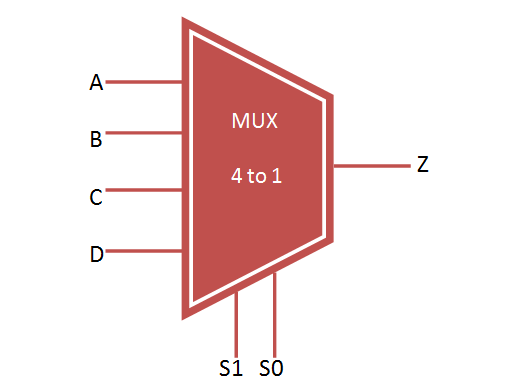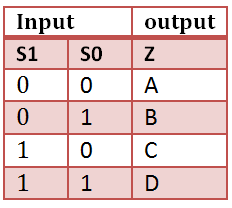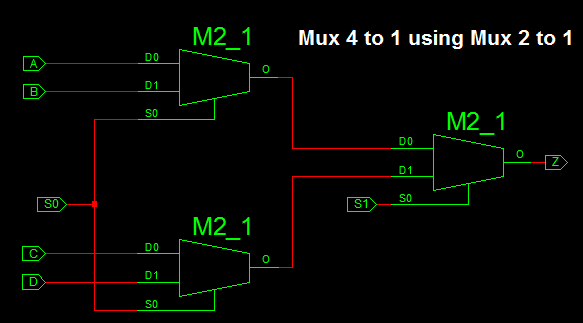Design and Simulation of Mux Using Vhdl
Multiplexer
Multiplexer (MUX) select one input from the multiple inputs and forwarded to output line through selection line. It consist of 2 power n input and 1 output. The input data lines are controlled by n selection lines.
For Example, if n = 2 then the mux will be of 4 to 1 mux with 4 input, 2 selection line and 1 output as shown below.

Truth Table for Multiplexer 4 to 1

Mux 4 to 1 design using Logic Gates

VHDL Code For 4 to 1 Multiplexer
library IEEE; use IEEE.STD_LOGIC_1164.all; entity mux_4to1 is port( A,B,C,D : in STD_LOGIC; S0,S1: in STD_LOGIC; Z: out STD_LOGIC ); end mux_4to1; architecture bhv of mux_4to1 is begin process (A,B,C,D,S0,S1) is begin if (S0 ='0' and S1 = '0') then Z <= A; elsif (S0 ='1' and S1 = '0') then Z <= B; elsif (S0 ='0' and S1 = '1') then Z <= C; else Z <= D; end if; end process; end bhv;
VHDL TestBench Code for 4 to 1 Multiplexer
LIBRARY ieee; USE ieee.std_logic_1164.ALL; ENTITY tb_mux IS END tb_mux; ARCHITECTURE behavior OF tb_mux IS – Component Declaration for the Unit Under Test (UUT) COMPONENT mux_4to1 PORT( A : IN std_logic; B : IN std_logic; C : IN std_logic; D : IN std_logic; S0 : IN std_logic; S1 : IN std_logic; Z : OUT std_logic ); END COMPONENT; – Inputs signal A : std_logic := '0'; signal B : std_logic := '0'; signal C : std_logic := '0'; signal D : std_logic := '0'; signal S0 : std_logic := '0'; signal S1 : std_logic := '0'; --Outputs signal Z : std_logic; BEGIN – Instantiate the Unit Under Test (UUT) uut: mux_4to1 PORT MAP ( A => A, B => B, C => C, D => D, S0 => S0, S1 => S1, Z => Z ); – Stimulus process stim_proc: process begin – hold reset state for 100 ns. wait for 100 ns; A <= '1'; B <= '0'; C <= '1'; D <= '0'; S0 <= '0'; S1 <= '0'; wait for 100 ns; S0 <= '1'; S1 <= '0'; wait for 100 ns; S0 <= '0'; S1 <= '1'; wait for 100 ns; S0 <= '0'; S1 <= '1'; wait for 100 ns; end process; END;
Output Waveform for 4 to 1 Multiplexer

Another Method of Constructing VHDL 4 to 1 mux is by using 2 to 1 Mux. For that implementation first we have write VHDL Code for 2 to 1 Mux and Port map 3 times 2 to 1 mux to construct VHDL 4 to 1 Mux.
4 to 1 Mux Implementation using 2 to 1 Mux

VHDL Code for 2 to 1 Mux
library IEEE; use IEEE.STD_LOGIC_1164.ALL; entity mux2_1 is port(A,B : in STD_LOGIC; S: in STD_LOGIC; Z: out STD_LOGIC); end mux2_1; architecture Behavioral of mux2_1 is begin process (A,B,S) is begin if (S ='0') then Z <= A; else Z <= B; end if; end process; end Behavioral;
VHDL 4 to 1 Mux using 2 to 1 Mux
library IEEE; use IEEE.STD_LOGIC_1164.ALL; entity mux4_1 is port( A,B,C,D : in STD_LOGIC; S0,S1: in STD_LOGIC; Z: out STD_LOGIC ); end mux4_1; architecture Behavioral of mux4_1 is component mux2_1 port( A,B : in STD_LOGIC; S: in STD_LOGIC; Z: out STD_LOGIC); end component; signal temp1, temp2: std_logic; begin m1: mux2_1 port map(A,B,S0,temp1); m2: mux2_1 port map(C,D,S0,temp2); m3: mux2_1 port map(temp1,temp2,S1,Z); end Behavioral;
VHDL Testbench and Simulation Waveform for 4 to 1 mux using 2 to 1 mux is same as the above implementation.
Design and Simulation of Mux Using Vhdl
Source: https://allaboutfpga.com/vhdl-4-to-1-mux-multiplexer/
0 Response to "Design and Simulation of Mux Using Vhdl"
Postar um comentário